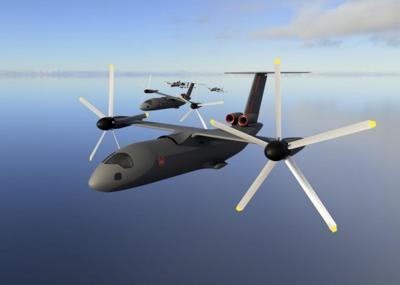Winning Designs to be Presented at Forum & Technology Display
The Vertical Flight Society (VFS) has named the winners of its 40th Annual Student Design Competition. The team representing the University of Maryland took first place in the Graduate category. The Georgia Institute of Technology/US Military Academy prevailed in the Undergraduate category. In addition, the Military Institute of Technology (Bangladesh) took Best New Undergraduate Entrant honors. The 2023 competition was sponsored by Sikorsky, which provided $12,500 in prize money.

The VFS competition challenges students to design a Vertical Take-Off and Landing (VTOL) aircraft meeting requirements specified by the competition’s proctors, thereby providing a practical exercise for collegiate engineering students and promoting interest in VTOL engineering and technology.
2023’s competition—titled High-Speed Vertical Take-Off and Landing (HSVTOL)—saw a total of 13 proposals submitted by academic teams hailing from four different countries. The contest’s Request for Proposals (RFP) called upon participating teams to design large VTOL aircraft capable of balancing sustained hover operations with high-speed and high-altitude cruise flight.
Entrant’s VTOL platforms were required to carry payloads of five-thousand pounds within an internal cargo bay measuring 6.5-feet high, eight-feet wide, and thirty-feet long. Vehicles were to manage mission radii of five-hundred-nautical-miles and cruise speeds of no less than 450-knots at altitudes greater than FL200.
Vehicle designs were to include features conducive to the mitigation of Foreign Object Debris (FOD) ingestion and rotor outwash/downwash on ground personnel and landing-zone environments.
The winning teams for the graduate category were:
- First Place: University of Maryland: Team Arion
- Second Place: Georgia Institute of Technology/Sapienza University: Team Soteria
- Third Place: Politenico di Milano (Milan, Italy): Team Raven-4
The winning entry in the graduate category was the University of Maryland’s Arion—named for the immortal mythical horse known for his extraordinary speed and bravery. The team’s design was a 48,000-pound mixed-power tiltrotor featuring two 39-foot proprotors. Arion is powered by two inboard turboshaft engines plus two turbofans on the base of the empennage for additional forward-thrust.
The winning teams for the undergraduate category were:
- First Place: Georgia Institute of Technology/U.S. Military Academy: Team Harpy
- Second Place: University of Maryland: Tam Karfi
- Third Place: Pennsylvania State University: Team Night Fury
- Best New Entrant: Military Institute of Science & Technology: Team MIST AVRO

The team representing the Georgia Institute of Technology and the U.S. Military Academy secured a victory in the undergraduate category with its Harpy concept. The name was inspired by harpy eagles, which are known for carrying heavy weights, and the half-human-half-bird harpies of Greek mythology. The 51,500-pound vehicle leveraged a novel configuration comprising two wingtip-mounted 36-foot diameter, two-bladed rotors. During high-speed forward flight, Harpy’s rotors are stopped and its retreating blades stored in the aircraft’s wings. The described architecture facilitates the minimization of drag while allowing the vehicle’s advancing blades to function as lifting surfaces. Harpy is powered by two Convertible Engine System Technology (CEST) turbofan/turboshaft engines driving rotors and providing cruise thrust.
Two members of each of the first-place winning teams were invited to present their designs at the 80th Annual Forum & Technology Display scheduled for 07-09 May 2024 in Montreal, Canada.
Sponsorship of the Annual Student Design Competition alternates between Airbus Helicopters, Bell, The Boeing Co., Bell, Leonardo, Sikorsky, and the DEVCOM Army Research Lab.
 ANN's Daily Aero-Term (05.17.24): Very High Frequency
ANN's Daily Aero-Term (05.17.24): Very High Frequency ANN's Daily Aero-Linx (05.17.24)
ANN's Daily Aero-Linx (05.17.24) ANN FAQ: Submit a News Story!
ANN FAQ: Submit a News Story! Classic Aero-TV: ANN Visits Wings Over The Rockies Exploration Of Flight
Classic Aero-TV: ANN Visits Wings Over The Rockies Exploration Of Flight Airborne Affordable Flyers 05.16.24: PRA Runway, Wag-Aero Sold, Young Eagles
Airborne Affordable Flyers 05.16.24: PRA Runway, Wag-Aero Sold, Young Eagles




